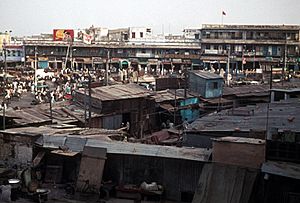Slum facts for kids

A slum is a part of a city or a town where many people live in very simple and often crowded homes. These areas might not have basic things like clean water, proper toilets, or good roads. People living in slums often face challenges like not having enough money or good jobs. You can find slums in most large cities around the world, though they might be called different names, like a shanty town.
Contents
What are Slums Like?
Slums are usually very crowded. Homes are often built close together, sometimes using materials like wood, metal sheets, or even plastic. There might not be enough space for everyone, and several families could share one small house.
Life in a Slum
Life in a slum can be tough. People often don't have access to clean drinking water, and sanitation systems (like sewers) might be poor or non-existent. This can lead to health problems. Getting a good education or finding steady jobs can also be difficult for people living in these areas.
Slums in History: Victorian London
Long ago, even big cities like London had areas that were like slums. A famous writer named Charles Dickens wrote about these places in Victorian times (the 1800s). He described a "rookery" (an old word for a crowded, poor area) in London.
Dickens wrote about houses with broken windows, patched up with rags and paper. Each room was rented to a different family, sometimes even two or three families shared one room! People ran small businesses from their homes, like selling fruit or fixing shoes. There were many people living very close together, and the streets were often dirty. This shows that slums are not just a modern problem; they have existed for a long time in many parts of the world.
Why Do Slums Exist?
Slums often grow when many people move to cities looking for jobs and a better life, but there aren't enough affordable homes for everyone. Sometimes, people can't afford to live in other parts of the city, so they build homes in areas that are less developed.
Images for kids
-
One of the many New York City slum photographs of Jacob Riis (ca 1890). Squalor can be seen in the streets, wash clothes hanging between buildings.
-
A slum dwelling in Toronto, Ontario, Canada, about 1936.
-
A 1913 slum dwelling midst squalor in Ivry-sur-Seine, a French commune about 5 kilometers from center of Paris. Slums were scattered around Paris through the 1950s. After Loi Vivien was passed in July 1970, France demolished some of its last major bidonvilles (slums) and resettled resident Algerian, Portuguese and other migrant workers by the mid-1970s.
-
A slum in Rio de Janeiro, Brazil. Rocinha favela is next to skyscrapers and wealthier parts of the city, a location that provides jobs and easy commute to those who live in the slums.
-
An integrated slum dwelling and informal economy inside Dharavi of Mumbai. Dharavi slum started in 1887 with industrial and segregationist policies of the British colonial era. The slum housing, tanneries, pottery and other economy established inside and around Dharavi during the British rule of India.
-
Makoko – One of the oldest slums in Nigeria, was originally a fishing village settlement, built on stilts on a lagoon. It developed into a slum and became home to about a hundred thousand people in Lagos. In 2012, it was partially destroyed by the city government, amidst controversy, to accommodate infrastructure for the city's growing population.
-
A slum near Ramos Arizpe in Mexico.
-
Slum in Tai Hang, Hong Kong, in the 1990s
-
Slums in the city of Chau Doc, Vietnam over river Hậu (Mekong branch). These slums are on stilts to withstand routine floods which last 3 to 4 months every year.
-
A slum in Haiti damaged by 2010 earthquake. Slums are vulnerable to extensive damage and human fatalities from landslides, floods, earthquakes, fire, high winds and other severe weather.
-
A young boy sits over an open sewer in the Kibera slum, Nairobi.
-
Villa 31, one of the largest slums of Argentina, located near the center of Buenos Aires
-
A slum dwelling in Borgergade in central Copenhagen Denmark, about 1940. The Danish government passed The Slum Clearance Act in 1939, demolished many slums including Borgergade, replacing it with modern buildings by the early 1950s.
-
Housing projects in Bahia, Brazil
See also
 In Spanish: Barrios bajos para niños
In Spanish: Barrios bajos para niños























